#cancer subtypes.
Explore tagged Tumblr posts
Text
youtube
#ZFNet#Deep Maxout Network#cancer prediction#gene expression data#convolutional neural networks#genomic analysis#cancer classification#deep learning#machine learning#precision medicine#bioinformatics#computational oncology#dimensionality reduction#cancer diagnosis#AI in healthcare#personalized medicine#cancer detection#genomic biomarkers#neural networks#cancer subtypes.#Youtube
0 notes
Text

im doing a drawtober of characters i think of through the day and will post in batches. day 3 solo because its already been derailed and todays blorbo is immunochemistry.
#admin draws#self#not fanart#drawtober#shoutout to two group chats and one server tormented by me reading a research paper and going jesus christ. whatthefuck#Anyways i have some Opinions about how booster doses and vaccines were handled by companies that had all the money in the world#to do this shit right and figure out the lowest effective dose that grants all the benefits but instead went HMMM NOPE ACTUALLY#LETS GO ALL IN AND GIVE BIG DOSES EVERY TIME. JUST TO MAKE SURE IT WORKS#and guess what. whguess what happened dear reader.#if you guessed immune non-response to covid in shots 3 onwards then congratulations! you win a cookie. we are fucked tho.#IgG4 being the centerpiece of this shitshow has one upside and that is that its a very very interesting antibody subtype#i look forward to learning more about it. i wonder about its genesis and role. like ACTUAL role in a healthy body rather than just#pathological processes. where it is prominent in some other vaccines (again only in too large dosages mind you) cancer and autoimmune stuff#anways i love vaccines. vaccines rule. but pharma industry doesnt and their lack of caution in not recognizing that you can have too much#of a good thing and then it backfires and leaves you worse off than EVER. doesnt rule. it makes it quite bad actually#anyways classes started again. irregularly scheduled reminder that im a bioscience student LMAO
6 notes
·
View notes
Text
#Breast Cancer#What is Breast Cancer#Breast Cancer Types#Breast Cancer Subtypes#Symptoms of Breast Cancer#Causes of Breast Carcinoma#Diagnosis of Breast Cancer#Breast Cancer Stages#Breast Cancer Treatments#Breast Cancer Treatment Side effects#Prevention of Breast Cancer
0 notes
Text
How families can face cancer with confidence and hope-a book review
Dr. Lori Lindstrom Leifer shares her cancer journey as a physician and a patient in this book I reviewed on my blog. Another Women in Medicine month feature.
After You Hear It’s Cancer A Guide to Navigating the Difficult Journey Ahead By John Leifer with Lori Lindstrom Leifer, MD Dr. Lori Leifer, a radiation oncologist, was well qualified to author a book about cancer. As a physician who treats cancer with radiation, she has extensive training and experience managing patients diagnosed with this devastating disease. (Note: the photos and graphics…
#breast cancer#breast cancer subtypes#cancer treatment#Dr Lori Lindstrom#hospice#John Leifer#mammograms
0 notes
Text
Personalized Approaches to Cutaneous Squamous Cell Carcinoma Treatment: Targeting Tumor Diversity

Cutaneous Squamous Cell Carcinoma (cSCC) is a heterogeneous disease characterized by diverse clinical and molecular features. Personalized treatment approaches that take into account the unique characteristics of individual tumors have emerged as a promising strategy to improve treatment outcomes and patient survival.
Understanding Cutaneous Squamous Cell Carcinoma: Cutaneous Squamous Cell Carcinoma (cSCC) is a type of skin cancer that arises from the malignant transformation of squamous cells in the epidermis or its appendages. It encompasses a spectrum of disease presentations, ranging from localized lesions to metastatic tumors with varying clinical behaviors.
Tumor Heterogeneity and Molecular Subtypes: Cutaneous Squamous Cell Carcinoma (cSCC) exhibits considerable heterogeneity at the molecular level, with distinct genetic alterations and signaling pathways driving tumor progression and metastasis. Molecular subtyping studies have identified different subgroups of cSCC tumors based on their genomic profiles, providing insights into tumor diversity and potential therapeutic targets.
Precision Medicine in cSCC Treatment: Precision medicine approaches aim to tailor treatment strategies to the specific molecular characteristics of individual tumors, allowing for more targeted and effective therapies. By identifying actionable mutations or biomarkers, clinicians can select therapies that are most likely to benefit patients while minimizing the risk of treatment-related toxicities.
Genomic Profiling and Biomarker Identification: Advances in genomic sequencing technologies have enabled comprehensive profiling of cSCC tumors, revealing recurrent mutations in genes involved in cell cycle regulation, DNA repair, and immune evasion. Biomarker identification efforts seek to identify predictive markers of treatment response and prognosis, guiding treatment decisions in personalized medicine.
Get More Insights On This Topic: Cutaneous Squamous Cell Carcinoma
#Cutaneous Squamous Cell Carcinoma#Skin Cancer#Tumor Heterogeneity#Precision Medicine#Molecular Subtypes#Targeted Therapy#Immunotherapy#Biomarker Identification#Personalized Treatment
0 notes
Text
Where to Start Your Research When Writing a Disabled Character
[large text: Where to Start Your Research When Writing a Disabled Character]
So you have decided that you want to make a disabled character! Awesome. But what's next? What information should you decide on at the early phrase of making the character?
This post will only talk about the disability part of the character creation process. Obviously, a disabled character needs a personality, interests, and backstory as every other one. But by including their disability early in the process, you can actually get it to have a deeper effect on the character - disability shouldn't be their whole life, but it should impact it. That's what disabilities do.
If you don't know what disability you would want to give them in the first place;
[large text: If you don't know what disability you would want to give them in the first place;]
Start broad. Is it sensory, mobility related, cognitive, developmental, autoimmune, neurodegenerative; maybe multiple of these, or maybe something else completely? Pick one and see what disabilities it encompasses; see if anything works for your character. Or...
If you have a specific symptom or aid in mind, see what could cause them. Don't assume or guess; not every wheelchair user is vaguely paralyzed below the waist with no other symptoms, not everyone with extensive scarring got it via physical trauma. Or...
Consider which disabilities are common in real life. Cerebral palsy, muscular dystrophy, stroke, cataracts, diabetes, intellectual disability, neuropathy, multiple sclerosis, epilepsy, thyroid disorders, autism, dwarfism, arthritis, cancers, brain damage, just to name a few.
Decide what specific type of condition they will have. If you're thinking about them having albinism, will it be ocular, oculocutaneous, or one of the rare syndrome-types? If you want to give them spinal muscular atrophy, which of the many possible onsets will they have? If they have Ehlers-Danlos Syndrome, which one out of the 13 different types do they have? Is their amputation below, or above the knee (it's a major difference)? Not all conditions will have subtypes, but it's worth looking into to not be surprised later. This will help you with further research.
If you're really struggling with figuring out what exact disability would make sense for your character, you can send an ask. Just make sure that you have tried the above and put actual specifics in your ask to give us something to work with. You can also check out our "disabled character ideas" tag.
Here are some ideas for a character using crutches.
Here are some ideas for a character with a facial difference (obligatory link: what is a facial difference?).
If you already know what disability your character is going to have;
[large text: If you already know what disability your character is going to have;]
Start by reading about the onset and cause of the condition. It could be acquired, congenital, progressive, potentially multiple of these. They could be caused by an illness, trauma, or something else entirely. Is your character a congenital amputee, or is it acquired? If acquired - how recently? Has it been a week, or 10 years? What caused them to become disabled - did they have meningitis, or was it an accident? Again, check what your options are - there are going to be more diverse than you expect.
Read about the symptoms. Do not assume or guess what they are. You will almost definitely discover something new. Example: a lot of people making a character with albinism don't realize that it has other symptoms than just lack of melanin, like nystagmus, visual impairment, and photophobia. Decide what your character experiences, to what degree, how frequently, and what do they do (or don't do) to deal with it.
Don't give your character only the most "acceptable" symptoms of their disability and ignore everything else. Example: many writers will omit the topic of incontinence in their para- and tetraplegic characters, even though it's extremely common. Don't shy away from aspects of disability that aren't romanticized.
Don't just... make them abled "because magic". If they're Deaf, don't give them some ability that will make them into an essentially hearing person. Don't give your blind character some "cheat" so that they can see, give them a cane. Don't give an amputee prosthetics that work better than meat limbs. To have a disabled character you need to have a character that's actually disabled. There's no way around it.
Think about complications your character could experience within the story. If your character wears their prosthetic a lot, they might start to experience skin breakdown or pain. Someone who uses a wheelchair a lot has a risk of pressure sores. Glowing and Flickering Fantasy Item might cause problems for someone photophobic or photosensitive. What do they do when that happens, or how do they prevent that from happening?
Look out for comorbidities. It's rare for disabled people to only have one medical condition and nothing else. Disabilities like to show up in pairs. Or dozens.
If relevant, consider mobility aids, assistive devices, and disability aids. Wheelchairs, canes, rollators, braces, AAC, walkers, nasal cannulas, crutches, white canes, feeding tubes, braillers, ostomy bags, insulin pumps, service dogs, trach tubes, hearing aids, orthoses, splints... the list is basically endless, and there's a lot of everyday things that might count as a disability aid as well - even just a hat could be one for someone whose disability requires them to stay out of the sun. Make sure that it's actually based on symptoms, not just your assumptions - most blind people don't wear sunglasses, not all people with SCI use a wheelchair, upper limb prosthetics aren't nearly as useful as you think. Decide which ones your character could have, how often they would use them, and if they switch between different aids.
Basically all of the above aids will have subtypes or variants. There is a lot of options. Does your character use an active manual wheelchair, a powerchair, or a generic hospital wheelchair? Are they using high-, or low-tech AAC? What would be available to them? Does it change over the course of their story, or their life in general?
If relevant, think about what treatment your character might receive. Do they need medication? Physical therapy? Occupational therapy? Orientation and mobility training? Speech therapy? Do they have access to it, and why or why not?
What is your character's support system? Do they have a carer; if yes, then what do they help your character with and what kind of relationship do they have? Is your character happy about it or not at all?
How did their life change after becoming disabled? If your character goes from being an extreme athlete to suddenly being a full-time wheelchair user, it will have an effect - are they going to stop doing sports at all, are they going to just do extreme wheelchair sports now, or are they going to try out wheelchair table tennis instead? Do they know and respect their new limitations? Did they have to get a different job or had to make their house accessible? Do they have support in this transition, or are they on their own - do they wish they had that support?
What about *other* characters? Your character isn't going to be the only disabled person in existence. Do they know other disabled people? Do they have a community? If your character manages their disability with something that's only available to them, what about all the other people with the same disability?
What is the society that your character lives in like? Is the architecture accessible? How do they treat disabled people? Are abled characters knowledgeable about disabilities? How many people speak the local sign language(s)? Are accessible bathrooms common, or does your character have to go home every few hours? Is there access to prosthetists and ocularists, or what do they do when their prosthetic leg or eye requires the routine check-up?
Know the tropes. If a burn survivor character is an evil mask-wearer, if a powerchair user is a constantly rude and ungrateful to everyone villain, if an amputee is a genius mechanic who fixes their own prosthetics, you have A Trope. Not all tropes are made equal; some are actively harmful to real people, while others are just annoying or boring by the nature of having been done to death. During the character creation process, research what tropes might apply and just try to trace your logic. Does your blind character see the future because it's a common superpower in their world, or are you doing the ancient "Blind Seer" trope?
Remember, that not all of the above questions will come up in your writing, but to know which ones won't you need to know the answers to them first. Even if you don't decide to explicitly name your character's condition, you will be aware of what they might function like. You will be able to add more depth to your character if you decide that they have T6 spina bifida, rather than if you made them into an ambiguous wheelchair user with ambiguous symptoms and ambiguous needs. Embrace research as part of your process and your characters will be better representation, sure, but they will also make more sense and seem more like actual people; same with the world that they are a part of.
This post exists to help you establish the basics of your character's disability so that you can do research on your own and answer some of the most common ("what are symptoms of x?") questions by yourself. If you have these things already established, it will also be easier for us to answer any possible questions you might have - e.g. "what would a character with complete high-level paraplegia do in a world where the modern kind of wheelchair has not been invented yet?" is more concise than just "how do I write a character with paralysis?" - I think it's more helpful for askers as well; a vague answer won't be of much help.
I hope that this post is helpful,
mod Sasza
#mod sasza#writing reference#writing advice#writing resources#writeblr#writing disabled characters#writing resource#long post#writing tips#writing guide
3K notes
·
View notes
Text
The Best News of Last Week - March 18
1. FDA to Finally Outlaw Soda Ingredient Prohibited Around The World

An ingredient once commonly used in citrus-flavored sodas to keep the tangy taste mixed thoroughly through the beverage could finally be banned for good across the US. BVO, or brominated vegetable oil, is already banned in many countries, including India, Japan, and nations of the European Union, and was outlawed in the state of California in October 2022.
2. AI makes breakthrough discovery in battle to cure prostate cancer
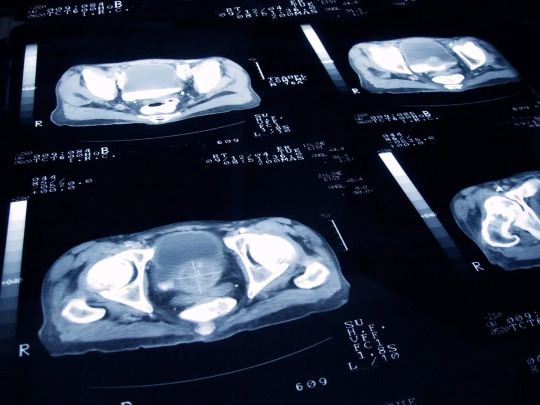
Scientists have used AI to reveal a new form of aggressive prostate cancer which could revolutionise how the disease is diagnosed and treated.
A Cancer Research UK-funded study found prostate cancer, which affects one in eight men in their lifetime, includes two subtypes. It is hoped the findings could save thousands of lives in future and revolutionise how the cancer is diagnosed and treated.
3. “Inverse vaccine” shows potential to treat multiple sclerosis and other autoimmune diseases
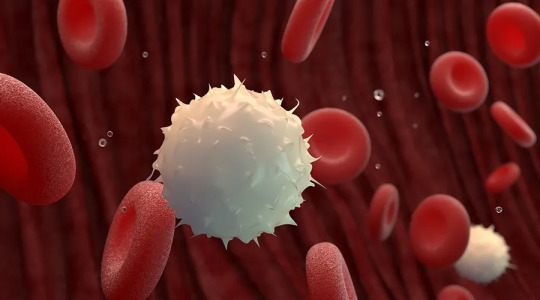
A new type of vaccine developed by researchers at the University of Chicago’s Pritzker School of Molecular Engineering (PME) has shown in the lab setting that it can completely reverse autoimmune diseases like multiple sclerosis and type 1 diabetes — all without shutting down the rest of the immune system.
4. Paris 2024 Olympics makes history with unprecedented full gender parity

In a historic move, the International Olympic Committee (IOC) has distributed equal quotas for female and male athletes for the upcoming Olympic Games in Paris 2024. It is the first time The Olympics will have full gender parity and is a significant milestone in the pursuit of equal representation and opportunities for women in sports.
Biased media coverage lead girls and boys to abandon sports.
5. Restored coral reefs can grow as fast as healthy reefs in just 4 years, new research shows

Planting new coral in degraded reefs can lead to rapid recovery – with restored reefs growing as fast as healthy reefs after just four years. Researchers studied these reefs to assess whether coral restoration can bring back the important ecosystem functions of a healthy reef.
“The speed of recovery we saw is incredible,” said lead author Dr Ines Lange, from the University of Exeter.
6. EU regulators pass the planet's first sweeping AI regulations

The EU is banning practices that it believes will threaten citizens' rights. "Biometric categorization systems based on sensitive characteristics" will be outlawed, as will the "untargeted scraping" of images of faces from CCTV footage and the web to create facial recognition databases.
Other applications that will be banned include social scoring; emotion recognition in schools and workplaces; and "AI that manipulates human behavior or exploits people’s vulnerabilities."
7. Global child deaths reach historic low in 2022 – UN report
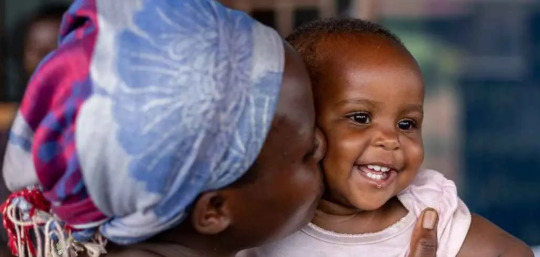
The number of children who died before their fifth birthday has reached a historic low, dropping to 4.9 million in 2022.
The report reveals that more children are surviving today than ever before, with the global under-5 mortality rate declining by 51 per cent since 2000.
---
That's it for this week :)
This newsletter will always be free. If you liked this post you can support me with a small kofi donation here:
Buy me a coffee ❤️
Also don’t forget to reblog this post with your friends.
782 notes
·
View notes
Text
Per one single request (and that is all I need to carry on) here is an expansion of my tags on this post
What even is dementia?
Basically, it's an umbrella term. It describes a set of common symptoms, primarily worsening cognitive loss.
It's kind of like saying you have a cold. A cold is not a diagnosis, it's a grouping of different illnesses, like rhino virus (the most common), influenza, covid, the list goes on.
So, you can have dementia and Alzheimer's, but you wouldn't describe yourself as having both. You'd say "I have a type of dementia, Alzheimer's disease." In the same way you'd say, "I have a cold, I think it's just a rhino virus but it's a whopping my ass."
So why'd you pick Alzheimer's for that example?
Well, Alzheimer's disease is the most common type of dementia. It's where all the stereotypes you'd know about it come from. This is gonna be a text heavy post, so have a graph

University of Queensland
Before I talk about them in more detail though, what's a brain?
Your brain is made up of segments that control different specific bits of your body.
I always knew that if you hit the back of your head you might go blind, cos the eye and sight stuff happens at the back of the head. This is true.

I love a copyright warning on a photo. This post constitutes personal use
Alright! An important thing about dementia is that it moves through the brain steadily, going piece by piece. It doesn't do it all at once. So you have a starting spot, and a progressive loss of cognition as it kills your neurons. We figure out the dementia type by the symptoms, cos the brain is so defined
So if you hit the back of your head, the green occipital lobe in that picture, you mess with your sight. If you lose cognition in the back of your head your eyes are seeing fine, but your cognition loss makes you process that sight incorrectly. What you see can be completely different to what other people see. This is posterior cortical atrophy, and I bring it up because we know someone who died from it, this is Terry Pratchett's dementia subtype

It's not on the above graph cos it's quite a rare type
Where's Alzheimer's start?
In the kinda middle bit, the temporal lobe. Memory, ya know. And once it takes your memory it'll move on, but it's not always the same, so people living with Alzheimer's disease will developed varying symptoms as the disease progresses, which takes many years. Sometimes people get a diagnosis of mixed dementia cos it's doing a few lobes at once. Or they have another quite different type of dementia at the some time
I'm not gonna talk about Alzheimer's much cos if you know anything about how dementia goes, you probably know it from Alzheimer's disease.
Let's go through a few others
Vascular dementia is the next biggie!
It's a curious one, this is stroke related. So, when you get a stroke you often lose cognition in the affected area of the brain. That's not dementia, that's a stroke!
But if you get lots and lots of strokes, constantly, that's a type of dementia. Cos you're getting steadily cognitively worse
(this is a good time to remind people that dementia is not a diagnosis or even a type of illness like cancer, it is a descriptive umbrella of common symptoms. The underlying causes can be wildly different)
Vascular dementia doesn't follow our moves steadily though the brain model, cos the strokes can and do happen anywhere. It's rough
What am I talking about, they're all rough. It'll get rougher
Lewy bodies dementia
Often cross diagnosed with Parkinson's disease dementia, it just depends if you get the physical or cognitive symptoms first.
Lewy bodies doesn't tend to have any memory loss. I know, no one thinks that's possible! But this is a dementia without memory loss! Cognitive loss is not the same thing as memory loss, theres other cognitive thing you can lose. That's why they're different words I guess
Of course, in all dementias eventually everything goes. Cos it's progressive, it keeps progressing
Lewy bodies is more likely to cause physical impacts like shaking and shuffling gait. You'll also hallucinate, have delusion, sleep badly, and experience mood swings.
From a care perspective, the people living with Lewy bodies disease are vastly more likely to be violent than any other person living with dementia
Robin Williams had this one, but he never knew. They confirmed via autopsy. So I'm gonna add a fun gif of him cos he was lovely

There's a lot of other disease/illness induced dementias
Huntington's turns into dementia eventually. HIV too. If you have down syndrome you have an extra gene that will always turn into dementia if you live long enough (that's one of our few 100% rates). Alcohol related dementia. So on and so forth. There's a shit tonne of types
Anyway, thats enough about disease progression. I'll talk out a few more common misunderstandings and then post
Is dementia fatal?
Sure is. Most people will die of something else while they have dementia, cos age often comes with comorbidities, but if the only thing you have is Alzheimer's disease it will still kill you. It's taking out your brain cells, eventually you'll forget how to swallow and choke.
Honestly tho it's more likely you'll die 'by accident' due to doing something you didn't realise was dangerous, like going for a walk wearing nothing at night and developing hypothermia. That is a dementia-caused death, I think we can all see that, but it'll be written down as hypothermia. So reported deaths are lower than what's true
Alzheimer's takes 10 - 30 years for the neuron loss to be extreme enough to kill you outright. Lewy bodies is more like 5 - 7 years. There's a range and the ranges are poorly defined, quiz your GP if this ever comes up in your life
It's an old person disease, right?
Overwhelmingly yes. It's considered younger onset if you're less than 65. But from the graph above you can see that's a big enough proportion to get its own slot
But kids don't get it
Sure they do, childhood dementia is a whole thing. It's awful. People are born with it. Again, dementia isn't an illness type, it's a symptom grouping. Kids can be born with progressive, worsening cognitive loss. So while it's not Alzheimer's disease, it is dementia. It's like 1 in 3000 kids have some kind of childhood dementia, and most die before they reach adulthood.
It's untreatable
It is incurable (but they keep researching!) but we have treatments for the early stages. If you or a loved one is experiencing confusion and memory loss, get moving early and you might be able to delay the worsening of symptoms for a few years. It's not a cure, but it's better than nothing. And it's all we've got
How do you, op, know?
I have a master's degree in dementia, and I work in the field. Not naming my job cos I'm not speaking for them rn, I'm just presenting what I know personally

Gonna end the post there. Send me asks or questions or whatever, I'll try and answer. If I get enough asking the same thing I'll do another post expanding on that ❤️❤️❤️
168 notes
·
View notes
Text
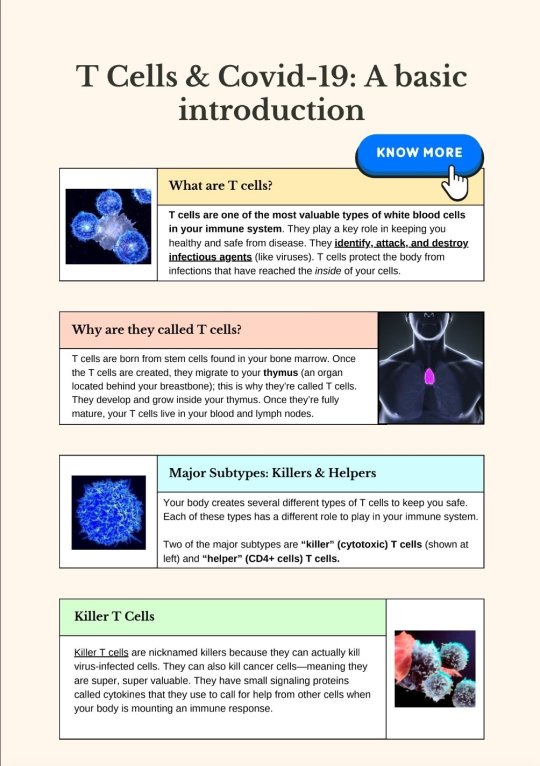
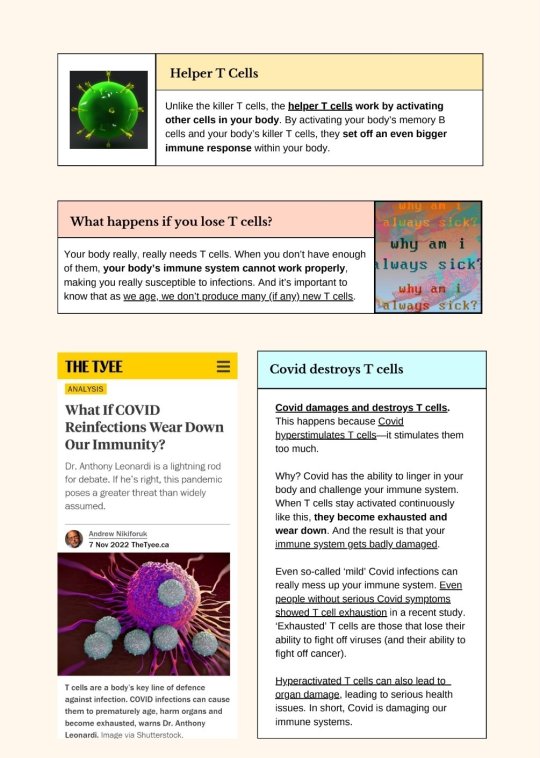
Source.
[ID: A two-page infographic titled "T Cells & Covid-19: A basic introduction."
A box labeled "What are T cells?" Text reads: "T cells are one of the most valuable types of white blood cells in your immune system. They play a key role in keeping you healthy and safe from disease. They identify, attack, and destroy infectious agents (like viruses). T cells protect the body from infections that have reached the inside of your cells." To the left of the box is an image of cells.
A box labeled "Why are they called T cells?" Text reads: "T cells are born from stem cells found in your bone marrow. Once the T cells are created, they migrate to your thymus (an organ located behind your breastbone); this is why they're called T cells. They develop and grow inside your thymus. Once they're fully mature, your T cells live in your blood and lymph nodes." To the right of the box is an image of a simplified human figure. The thymus' location is shown in bright pink in the center of the chest, roughly in the middle of the collarbone.
A box labeled "Major Subtypes: Killers & Helpers." Text reads: "Your body creates several different types of T cells to keep you safe. Each of these types has a different role to play in your immune system. Two of the major subtypes are 'killer' (cytotoxic) T cells (shown at left) and 'helper' (CD4+ cells) T cells." To the left of the box is a depiction of a blue cell.
A box labeled "Killer T Cells." Text reads: "Killer T cells are nicknamed killers because they can actually kill virus-infected cells. They can also kill cancer cells--meaning they are super, super valuable. They have small signaling proteins called cytokines that they use to call for help from other cells when your body is mounting an immune response." To the right of the box is an illustration of what appears to be killer T cells fighting infected or malign cells.
A box labeled "Helper T Cells." Text reads: "Unlike the killer T cells, the helper T cells work by activating other cells in your body. By activating your body's memory B cells and your body's killer T cells, they set off an even bigger immune response within your body." To the left of the box is a depiction of a green cell.
A box labeled "What happens if you lose T cells?" Text reads: "Your body really, really needs T cells. When you don't have enough of them, your body's immune system cannot work properly, making you really susceptible to infections. And it's important to know that as we age, we don't produce many (if any) new T cells." To the right of the box is a graphic where the words "why am i always sick?" appear multiple times in different colours.
A screenshot of an article from the Tyee, titled "What If COVID Reinfections Wear Down Our Immunity?" by Andrew Nikiforuk, dating from 7 November 2022. What text is visible reads: "Dr. Anthony Leonardi is a lightning rod for debate. If he’s right, this pandemic poses a greater threat than widely assumed", followed by an image of cells. Under the image, text reads: "T cells are a body’s key line of defence against infection. COVID infections can cause them to prematurely age, harm organs and become exhausted, warns Dr. Anthony Leonardi. Image via Shutterstock."
A box labeled "Covid destroys T cells." Text reads: "Covid damages and destroys T-cells. This happens because Covid hyperstimulates T cells--it stimulates them too much. Why? Covid has the ability to linger in your body and challenge your immune system. When T cells stay activated continuously like this, they become exhausted and wear down. And the result is that your immune system gets badly damaged. Even so-called 'mild' Covid infections can really mess up your immune system. Even people without serious Covid symptoms showed T cell exhaustion in a recent study. 'Exhausted' T cells are those that lose their ability to fight off viruses (and their ability to fight off cancer.) Hyperactivated T cells can also lead to organ damage, leading to serious health issues. In short, Covid is damaging our immune systems."
/end ID]
To read more on this topic:
How the Coronavirus Short-Circuits the Immune System (26 Jun, 2020)
Dendritic cell deficiencies persist seven months after SARS-CoV-2 infection (21 Jul, 2021)
SARS-CoV-2 Actively Infects And Kills Lymphoid Cells (14 Apr, 2022)
In Cleveland and beyond researchers begin to unravel the mystery of long COVID-19 (22 Oct, 2022)
What if COVID Reinfections Wear Down Our Immunity? (7 Nov, 2022)
Single-cell multiomics revealed the dynamics of antigen presentation, immune response and T cell activation in the COVID-19 positive and recovered individuals (2 Dec, 2022)
SARS-CoV-2 infection weakens immune-cell response to vaccination: NIH-funded study suggests need to boost CD8+ T cell response after infection. (20 Mar, 2023)
Lymphocytopenia: Merck Manual (Revised Apr 2023)
Long COVID manifests with T cell dysregulation, inflammation and an uncoordinated adaptive immune response to SARS-CoV-2 (11 Jan, 2024)
91 notes
·
View notes
Text
For 7 years I have been fucking fighting with insurance, with the help of several doctors, to cover a geneticist. I have Ehlers Danlos. Most forms don't effect life span. The ones that do, have organ involvement.
I already had two issues with my organs by the age of 20. I had to be hospitalized with sepsis for one of them. My liver is weirdly structured to the point they thought I had a fatal disease, before they realized it just has strictures and odd shapes, and a more benign disorder which doesn't explain why it's shaped like that.
I've had several doctors think I had a decent chance of having vascular subtype and that I NEEDED to get it tested NOW
But over and over and over insurance says no. They say only 5% of eds patients have this subtype so it's not worth looking into
I was hospitalized with sepsis bc of organ issues the week after my 18th birthday.
Vascular eds has a median life expectancy of 48. Meaning half don't make it that far. Patient survival was 99.3% at year 1, 89.9% at year 5, and 83.4% at year 10 of follow-up.
Yet insurance wants me to just shrug and accept that a single fall could have my veins or organs burst and kill me. Without any opportunity to be prepared for it or take meds to soften the risk. Because geneticists are too expensive to justify. Even with my symptoms, even with teams of doctors working years to get me in. insurance won't budge.
The billionaires running this wouldn't accept this level of lethal risk for their own health. But I'm supposed to sympathize? I'm supposed to give a fuck about their chance of death and the fear they may feel?
This isn't even counting that they took my mother away from me when I was 8 years old, because she couldn't get cancer treatment covered until it was stage 4. It doesn't count the sheer agony I have gone through when eds led into a preventable spinal cord injury, and many more smaller spinal complications. I had to threaten to fucking kill myself over the pain to get any pain relief. Even with my scans. And it's still not enough. I'm still in enough pain that it affects every single moment of my life. Even the best ones.
I have no empathy for them, or the people who are morally corrupt enough to love monsters like them.
10 notes
·
View notes
Text
What To Know Before Writing an Albino Character
1) General Information:
Albinism is a genetic disorder that results in decreased production of a pigment called melanin in the skin, hair, and eyes, resulting in light color or no color. Albinism is not a disease, nor do people "suffer" from it — though every albino person has their own thoughts and feelings regarding their condition. There's no cure for albinism. People with albinism are more likely to be diagnosed with skin cancer, as well as dealing with things like sun burns, but besides sight problems and eye sensitivity, most people with albinism are just as healthy as everyone else.
People with albinism are typically diagnosed at birth, as doctors can tell by their appearance. If albinism is suspected, a doctor can order a genetic test to get the most accurate results regarding type and gene mutation. Due to eye complications that come with albinism, some doctors will asks for babies to be seen by optometrists. During those eye examinations, doctors can find out if the patient has rapid eye movement, sensitivity to bright light, or misalignment of the eyes. Most people with albinism have photophobia (extreme sensitivity to bright lights), refractive errors (such as astigmatism, myopia, hyperopia), nystagmus (involuntary movement of the eyes, which can lead to abnormal head positioning), or strabismus (misalignment of the eyes).
Due to low or reduced melanin, people with albinism are extremely vulnerable to UV sun damage. To avoid damage from the sun, people with albinism are advised to wear protective clothing, hats, and sunscreen.
Along with that, people with albinism wear glasses that block out UV rays. They also use softer lights in their homes and on their electronic devices. Some albinos experience pain or headaches after being exposed to intense bright colors or eyestrain, which causes them to lean more towards pastels when regarding things they'll have to look at a lot.
People do not always like being referred to as albino, sometimes preferring the term "person/people with albinism." Many don't care, but it's overall regarded as disrespectful and sometimes derogatory to call someone "an albino/albinos" rather than an albino person or the previous listed term.
2) Types of Albinism:
There are two main types of albinism: oculocutaneous albinism (OCA) – the most common type, affecting the skin, hair and eyes, and ocular albinism (OA) – a rarer type that mainly affects the eyes. OCA is the type of albinism that most people are familiar with and that is represented more in the media. People with OA typically look the same as non-albino people, with the exception of their eyes. However, some do have slightly ligher hair and skin colors from their family members, but not by a very big extent. Their visual acuity is typically lower than normal, ranging from 20/60 to 20/400.
OA1 is caused by a change in the GPR143 gene that plays a signaling role that is especially important to pigmentation in the eye. OA1 follows a simpler pattern of inheritance because the gene for OA1 is on the X chromosome. Females have two copies of the X chromosome while males have only one copy (and a Y chromosome that makes them male). To have ocular albinism, a male only needs to inherit one changed copy of the gene for ocular albinism from his carrier mother. Therefore almost all of the people with OA1 are males. While possible if the mother is a carrier of ocular albinism and the father has ocular albinism, it is extremely rare.
As for OCA, there are currently seven forms of oculocutaneous albinism recognized – OCA1, OCA2, OCA3, OCA4, OCA5, OCA6 and OCA7. Some are further divided into subtypes. For OCA, both parents must carry the albinism gene for their child to inherit the condition.
OCA1, or tyrosinase-related albinism, results from a genetic defect in an enzyme called tyrosinase. This enzyme helps the body to change the amino acid, tyrosine, into pigment. (An amino acid is a “building block” of protein.) There are two subtypes of OCA1. In OCA1A, the enzyme is inactive and no melanin is produced, leading to white hair and very light skin. In OCA1B, the enzyme is minimally active and a small amount of melanin is produced, leading to hair that may darken to blond, yellow/orange or even light brown, as well as slightly more pigment in the skin.
OCA2, or P gene albinism, results from a genetic defect in the P protein that helps the tyrosinase enzyme to function. People with OCA2 make a minimal amount of melanin pigment and can have hair color ranging from very light blond to brown.
OCA3 is rarely described and results from a genetic defect in TYRP1, a protein related to tyrosinase. People with OCA3 can have substantial pigment.
OCA4 results from a genetic defect in the SLC45A2 protein that helps the tyrosinase enzyme to function. People with OCA4 make a minimal amount of melanin pigment similar to people with OCA2.
OCA5–7 were recognized in humans in 2012 and 2013. They have reported mutations on three additional causative genes. As gene testing becomes available, and more people with these types of albinism are identified, the complete range of physical manifestations will be recognized, and may overlap with other known types of OCA. Currently, these types of albinism are considered to be uncommon.
Albinism occurs in all race and ethnic groups across the world, but there are some types that are more common amongst certain groups. The most common types of albinism found in the black population of Southern Africa are OCA2 and OCA3. OCA3 is also the most common type found amongst Asian populations. It's important to do research on people with albinism who are the same ethnic/racial group as your character(s) to make sure you are representing them correctly as albinism looks different for each group of people.
As a side note, it's important to know that people with albinism do not always have red eyes. Even those who appear to have red eyes don't actually have that eye color, but it's rather a result of the lack of pigment, which makes the iris paler and thus, the retina more visible. People with albinism can have pretty much any eye color as long as it's a light shade; I've personally met other albino people who've had blue, red, pink, green, purple, and even yellow. In pictures, however, they eyes typically always appear some shade of red.
3) Recognize How People With Albinism Are Treated:
In places like China, having albinism is considered bad luck and many who have it are ostracized and excluded from mainstream society. They're also considered unattractive and inferior to many. Besides their physical disabilities, many Chinese people with albinism say that finding a partner is their biggest struggle.
Africa is one of the most dangerous places for albino people. In West Africa, some communities and families consider it a misfortune to give birth to Albinos and hence, attempts are made to either kill them at birth or banish them from the community. They are constantly abused and ridiculed by the public with derogatory names and social tags that serve as a form of stigmatization.
In many countries of sub-Saharan Africa, people with albinism suffer discrimination and ostracism and are seen as a curse. Many superstitions look at people with albinism as a source of income, so they are mutilated and the parts of their bodies are used in rituals of black magic, under the belief that they give wealth and fortune to those who own them. Some cultures believe that they do not die, but disappear, or that having sex with a person with albinism cures AIDS — which causes a high rate of sexual assault amongst those with albinism.
Not all places view albinism as bad though. In Panama, many people view those with albinism as lucky. In America, many people don't may much mind to those with albinism besides staring and making comments.
Overall, it's worthy to note how people with albinism are treated in the country your character(s) live in. Albinism dictates a lot in people's lives, but for some it can be the cause of their death or severe injury and trauma. People with albinism don't want extensive descriptions of their own trauma, but it's important to not gloss over how they're treated. If your character is from a fantasy setting then you can attempt to reflect how they're treated by looking at countries in the real world most similar to your fictional one.
4) Things To Avoid:
In Hollywood, people with albinism are often depicted as evil. It's become very rare that someone with this condition is viewed positively, they're always either a villain or a comedic relief character whose condition is used to mock them. Avoid both of these as much as you can. If you'd like to make your character with albinism a villain, make them compelling and give them a justifiably reason for their path: don't just make them someone whose naturally evil. If they're comedic relief, don't make them being albino apart of their jokes — give them a personality and make them likable.
Don't make them albino just because you think it's cool. Almost every person with albinism identifies as disabled and it's important to showcase their struggles, specifically with their sight and how they interact with situations that involve bright lights and such. Make sure you're not making them into a pity show, though, as disabled characters shouldn't solely revolve around their disabity. A good example of a character whose disability is a main part of her character but not the only part of it is Toph Beifong from Avatar: The Last Airbender, who is blind like many albino people. That's not to say that people with disabilities are or should be defined by their struggles, but that those struggles are real and often difficult to navigate. They are part of us and help to make us who we are. It might just be my opinion, but if you can ignore all their hardships then that's not an authentic portrayal of anything, really.
People with albinism are also very likely to be bullied for their appearance and viewed as unattractive, so it can be very positive representation to show your albino character as attractive. They don't have to be the most beautiful person in the cast, nor should you fetishize them for being disabled, but it can be nice to show other characters having feelings for them or giving them a romantic partner.
And most importantly, don't make them albino for no reason. Why does your character have albinism? What character or narrative purpose does it serve? How would the story be different if they didn't have albinism? Ask yourself these questions, and if you can't come up with good answers then maybe your character shouldn't have albinism. Think about how being albino affects them, the people around them, their story, and the overall plot. Are you making them albino for the sake of seeming diverse and woke or because you want to represent this group of people?
If your story is leaning into fantasy then you can come up with very easy explanations for why your character is albino. Maybe their people live underground and evolving to have albinism was what as best for their survival. Maybe your character is a clone, in which case they don't need their parents to have the albinism gene.
5) Closing Notes
This is just a general overview for people to get started on writing their albino characters. It's important to talk with actual albino people as you continue writing. Please do your own research on people with albinism to get more detailed insight on the condition.
If you're making a professional piece of work then you consider hiring an albino sensitivity reader to help ensure your depictions are appropriate. If there's anything you're unsure of in the meantime, researching or asking an albino person is best.
#if anyone with albinism has anything to add feel free!!#writing advice#albino characters#albinism#actually albino#albino representation#writing tips#oh and im albino just in case it wasn't clear#aloeverants
374 notes
·
View notes
Text
youtube
#CoQ10 levels#breast cancer#Pakistani women#oxidative stress#antioxidants#cancer biomarkers#cellular metabolism#Coenzyme Q10 deficiency#cancer progression#energy production#female patients#oncology research#cancer prevention#oxidative damage#personalized medicine#nutritional interventions#enzyme analysis#breast cancer subtypes#cancer diagnostics#prognostic markers.#Youtube
0 notes
Text
thomas' vague "skin disease"
someone please correct me if i'm wrong, but i don't think thomas has ever gotten an explicit diagnosis for his skin disorder in canon?? i know in a comic it's referred to as "skin cancer", despite the fact that if thomas truly had cancer since birth (??) and it eventually worsened to the point of eating away his nose, he would be dead. straight up. cancer, untreated? i know that boy is strong, but he is dead!
i've also seen it described as a vague "skin-eating disease", though when you look it up, such a disorder would require immediate care and show many more symptoms such as pain, fever, and vomiting. and again, i don't think thomas would have survived 30+ years with such a disease.
i am so terribly obsessed with this Franchise and This Man in particular so you bet your ass that i wanted to find something definitive to diagnose him with—and i think i found something!
after some research, i found a chronic skin disease called rosacea, and i specifically think thomas could have 2 subtypes at the same time:
subtype 2: papulopustular (or acne) rosacea, is associated with acne-like breakouts, and often affects middle-aged women.
subtype 3: known as rhinophyma, is a rare form associated with thickening of the skin on your nose. it usually affects men and is often accompanied by another subtype of rosacea.
now, despite thomas losing his Entire Nose by 1973, the rest of this could Work Out i think. perhaps he could have a really aggressive form of this disorder (since men who develop it are more likely to have more severe symptoms than women), and due to the acne-like breakouts caused by subtype 2, thomas could be left with discolored scarring, which we already know he has. since it has no cure, i could also see thomas growing frustrated with no amount of washing and scrubbing his face working to get rid of the disease, eventually leading to him trying to Cut the infected skin Out (as we learn he did during the beginning of the 2006 movie). as for most people afflicted with rosacea being between 30 and 60, let's just say thomas is part of the unlucky 13% that develop it in adolescence.
of course this isn't 1-to-1 with thomas' symptoms, but i wanted to try and find something to explain them. i think i will begin writing and drawing him with this "Diagnosis" in mind, but this is by no means an attempt to say that i'm Right and other people should Listen to Me. thomas is Not a Real Person after all, i just thought it'd be interesting to speculate!
#thomas hewitt#tcm#the texas chainsaw massacre#leatherface#texas chainsaw massacre#text#shut up forrest#tcm 2003#tcm 2006#slashers#headcanons#thomas hewitt headcanons
51 notes
·
View notes
Text

Been a while since I’ve posted on here but surprise, I have cancer - Classic Hodgkin Lymphoma nodular sclerosis subtype stage 2b to be exact. I’m in treatment though and still performing! I’m hosting this event this upcoming Sunday at the Middleboro Elks in Middleboro, Massachusetts and I’d love for you to join in person or digitally.
We will be performing The Rocky Horror Picture Show, Repo: The Genetic Opera, and having a Drag Performance. I will be one of the criminologists of the night as well as Marni in Repo. All will be live-streamed as well.
You can find more information at https://linktr.ee/fcancerfair
You can grab tickets to the performances here:
https://www.eventbrite.com/e/f-cancer-vendor-fair-and-performance-festival-tickets-931961851987
Hope to see you there and sending all my love to the Rocky Horror community ❤️
8 notes
·
View notes
Text
How families can face cancer with confidence and hope-a book review
Dr. Lori Lindstrom Leifer shares her cancer journey as a physician and a patient in this book I review for my blog. A blog reader commented, "Great to share a resource like this. It’s such a difficult time and people want to help but are scared and don’t know how."
After You Hear It’s Cancer A Guide to Navigating the Difficult Journey Ahead By John Leifer with Lori Lindstrom Leifer, MD Dr. Lori Leifer, a radiation oncologist, was well qualified to author a book about cancer. As a physician who treats cancer with radiation, she has extensive training and experience managing patients diagnosed with this devastating disease. (Note: the photos and graphics…
#breast cancer#breast cancer subtypes#cancer treatment#Dr Lori Lindstrom#hospice#John Leifer#mammograms
0 notes
Note
Hey! Thanks so much for all your work — seeing your answers has helped me be a lot more conscious of ableism in media. I have a question about a character I’m writing.
The story is a climate fiction story set in the fairly near future, and the origins of their disability is traced back to water pollution. The effects of the disability are that they are in a scooter.
One of the things you say all the time that I really appreciate is when writing disabled characters make sure they have a specific disability which characteristics you can research — but I’m not totally sure how to research disabilities connected to pollution? I am thinking the character’s disability will be connected with lung issues, which then connect with certain types of muscular atrophy, hence the wheelchair. But this is kind of just guesswork based on some inconclusive googling and what I know of pollution-related health conditions.
Any thoughts or tips?
Thanks!
Hey!
I think that a disability related to pollution is a very interesting premise. I myself have a family member who has a congenital disability due to radiation pollution, it's nice to see it represented.
Some things to consider that could help you with further research;
Were they born with it or is it progressive? Some pollution conditions, like Minamata Disease, could be both, but the symptoms can vary between them. E.g. it wouldn't make sense to give your character microcephaly if they became disabled at 23, but it would if it's congenital.
If possible, try to pinpoint what specifically is causing the water pollution. Heavy metals? Radiation? Chemical spill? There are a lot of incredibly specific pollution conditions. If you can think of it, it probably already happened. This can be research of the incredibly boring variety, but once you find something that works "enough" it will make things easier going forward.
Examples: heavy metals will often cause neurological problems (including ataxia), radiation will cause extremely high rates of various (blood and thyroid, for example) cancers even decades after the exposure, chemical spills can cause almost anything.
If you're going for lung issues, I would research Pneumoconiosis. Apologies for the link to Wikipedia, but it leads to a ton of different subtypes that you could be useful to look into. It talks about dust pollution, but generally if it's in the air then it's going to be in the water soon too.
Using a scooter can be helpful for an incredibly wide range of conditions, including COPD (Chronic Obstructive Pulmonary Disease) which is a common symptom of various pollution diseases.
Establishing the exact cause will also help you with worldbuilding - if the chemical polluting has a 90% fatality rate, it will be very different from one with <1%. If there's radiation, are unaffected people going through health anxiety due to the obvious cancer risk? Are local animals going extinct, how is the vegetation changing?
For water pollution specifically, think of how it affects the whole community - is rainwater safe to drink, are there ways to clean it, are there any fish to eat? Etc.
I would also research the conditions that you might not necessarily think about, like bacterial or fungal ones. Here's a page on water-based diseases and their effects, as well as potential causes.
This is a very hard to exhaust topic as there's probably a million ways to pollute water, but I tried my best, I wish you good luck with writing. I think it's important to bring attention to these kinds of things.
I hope this helps,
mod Sasza
61 notes
·
View notes